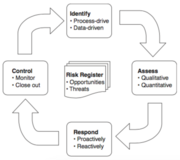Risk Management in Construction Projects
| Line 75: | Line 75: | ||
<blockquote> | <blockquote> | ||
<p>''”The objectives of project risk management are to increase the likelihood and impact of positive events, and decrease the likelihood and impact of negative events in the project.”''</p> | <p>''”The objectives of project risk management are to increase the likelihood and impact of positive events, and decrease the likelihood and impact of negative events in the project.”''</p> | ||
| − | <p> | + | <p>''''Project Management Institute'''' <ref name=PMBOK/></p> |
</blockquote> | </blockquote> | ||
Revision as of 14:31, 22 February 2018
Uncertainty is a fundamental factor of projects. We know that we cannot predict the future with certainty. Uncertainty converse all of the environmental conditions in which a project has to operate, e.g. costs of people or materials, etc. [1]
There are two types of uncertainty; uncertain effectiveness and uncertain efficiency. These uncertainties have different effects on a project. Uncertain effectiveness can affect the quality of the project, such as the understanding of requirements, prioritization of conflicting requirements or reasonableness of requirements. While uncertain efficiency can affect the quality of process performance against the plan, such as the availability of resources, quality of the planning process, technological capabilities, the ability and drive of the people.[2]
Risk is an uncertain event or condition which can have a positive or negative effect on one or more objectives in a construction project, such as; scope, schedule, cost, performance and quality. One or more of these can be of impact on the project, and have both positive and negative outcomes. Positive- and negative-outcome risks are referred to as opportunities and threats for the project, and it is the management of all these that constitute the Risk Management in Construction Projects.
Risks are present already from the time a project starts. Therefore it is important to prioritize risk management, since it will likely lead to more problems if handling the risks is procrastinated.
The goal of risk management is to increase the likelihood and impact of positive events and meanwhile decrease the likelihood and impact of negative events in construction projects. [3]
For understanding risk, we have to look at the four fundamental elements, which are defined as risk management process:
- Identify
- Assess
- Respond
- Control
Risk management is a learning process through time and through the whole project life cycle. [4]
Contents |
Risk Timeline

Risk Management Process

Identification

Identification of risks is the first step through the risk management process. This process is usually influenced by experience from previous projects and information gathered by brainstorming sessions with the team when starting a construction project [4].
Risk identification is a repeated process due to the fact that new risks may occur or become known through a construction project’s life cycle. Each risk should be understood clearly in order to handle them effectively. [3]
The identification process helps determine potential risk events that might either have a positive (opportunities) or negative (threats) impact on the construction project’s goals [5].
Donald Rumsfeld’s known knowns concept helps categorize types of risks associated with a project. The known-knowns refers to things that are known to be known, risks that already are identified/planned. The known-unknowns refers to things that we know we don’t know [2], an example could be extra employees in the construction processes due to a schedule delay; if the construction project has to be put on hold due to bad weather conditions. The unknown-knowns refers to things that should be known but is known wrongly, or not known at all [2]; these are, for example, risks that someone already knows about but is keeping private[4]. Lastly, the unknown-unknowns refers to things that are unknown to be unknown [2] or “black swans”. These are risks that have not been identified and therefore are unknown[4].
Assessment and Analysis

The second phase of the risk management process is to assess and analyze the risks that have been identified. There are many tools for assessing these risks, one of them are the Probability/Impact Matrix [4]. Each risk identified are rated on its probability of occurrence and impact on the construction project. The risk can be classified as low, moderate and high as seen on the figure, on the right. This matrix gives an overview of how much each risk have of a negative impact or threat to the construction project.
The impact factor on the x-axis is defined as how large of a negative impact the risk has on the construction project and the probability factor on the y-axis is defined as probability of the risk occurring.
A risk with a low impact and a low probability, bottom left corner, can often be ignored or accepted.
A risk with a low impact and a high probability, upper left corner, is of moderate priority and can be confronted or managed by transferring the risk to a third party.
A risk with a high impact and a low probability, bottom right corner, has a high priority but is unlikely to happen. An example might be a rare natural catastrophe or a fire on site and so on.
A risk with a high impact and a high probability, upper right corner, is of critical priority. Such a risk should be first priority and must be paid close attention to. [3]
Response

Having assessed the risk with the Probability/Impact Matrix, the next phase of the risk management process can be initiated. This is response to the risks. This is not only about reducing all the amount of risks, but by deciding whether to avoid, reduce, transfer or accept the risks, also known as the ARTA strategy. ARTA strategy should match the risks from the probability/impact matrix.
If the risk is of high impact and high probability, the correct corresponding action would be to avoid the risk altogether. In such an event the project team acts to eliminate the threat or protect the construction project from the risk’s impacts. This typically involves changing the strategy, or reducing the scope. Some of the risks can already be identified in the beginning of the construction projects, which means that the risks can be avoided by clarifying requirements, obtaining relevant information and expertise or improving communication.
If the risk is of high impact and low probability, the correct corresponding action would be to reduce the risk. In the case of such an event the project team acts to reduce the probability of occurrence or impact of a risk. Taking early action of reducing risks in a construction project is often far more effective than trying to adjust for the resulting impact later on.
If the risk is of low impact and high probability, the correct corresponding action would be to transfer the risk to a third party. This means that a third party would take over responsibility for the potential impact of a specific risk, such as a subcontractor, consulting firm and so on. A proper third party to transfer the risk to, would be one who holds expertise concerning that specific risk.
If the risk is of low impact and low probability, the proper decision would be to accept the risk. Then the project team decides to acknowledge the risk and not take any action unless the risk occurs [3] . An example would be if the contractor has to accept the weather conditions; there is nothing they can do about delays in the schedule due to weather conditions.
Control
The last phase of the risk management process is to monitor or control risks throughout the construction project’s life cycle. This phase is as important as the other phases and during this phase the unknown-unknown events will grow [4]. Monitoring and controlling risks can be achieved by tracking the identified risks, monitoring continuing risks, identifying new risks, and evaluating risk process effectiveness [3] throughout the construction project life cycle. Additionally, monitoring and controlling is assisted by gathering relevant people on the construction project for routine meetings on the construction site. This activity can identify both positive and negative effects on the construction project [4].
Limitation
Risk management will improve numerous tasks of a construction project, but of course there are limitations. As mentioned earlier:
”The objectives of project risk management are to increase the likelihood and impact of positive events, and decrease the likelihood and impact of negative events in the project.”
'Project Management Institute' [3]
Risk management is not about removing all risks from construction projects, as this is impossible. But rather, it is to reduce the amount of negative impacts. Risk management is therefore only limited to the extent that it is possible to identify and assess risks, known or unknown. Furthermore, risk management can both be limited in its ability to decrease impact and likelihood of negative impacts, as well as in its ability to increase likelihood and impact of positive impacts.
A common tendency amongst risk managers is that the majority of their focus is on decreasing negative impact associated risks. Ideally equal importance should be given to increasing positive impact associated risks. Limitations to the benefit of doing risk management therefore arise when an imbalanced prioritization is given to these [3].
Annotated bibliography
References
- ↑ Taylor, Harvey | 2010 | Project Management | (4th Edition)
- ↑ 2.0 2.1 2.2 2.3 2.4 2.5 2.6 Geraldi, Joana | Thuesen, Christian | Oehmen, Josef | 2016 | "How to DO projects" | Uncertainty |(Version 0.5)
- ↑ 3.0 3.1 3.2 3.3 3.4 3.5 3.6 Project Management Institute | 2013 | "A Guide to Project Management Body of Knowledge" | (5th Edition)
- ↑ 4.0 4.1 4.2 4.3 4.4 4.5 4.6 4.7 4.8 Winch, Graham M. | 2010 | "Managing Construction Projects" | (2nd Edition)
- ↑ Dansk Standard | 2013 | "Guidance on project management" | DS/ISO 21500 | (2nd version)